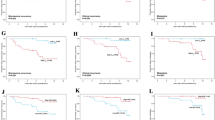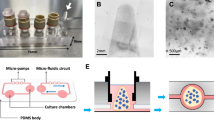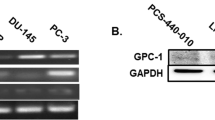Abstract
Purpose: To quantify the ex vivo production of proangiogenic proteins (vascular endothelial growth factor (VEGF), basic fibroblast growth factor (bFGF), urokinase-type plasminogen activator (u-PA), tissue-type plasminogen activator (tPA)) and angiogenesis inhibitors (plasminogen activator inhibitor type-1 (PAI-1) and angiostatin) from epithelial and stromal components of primary prostate cancer (CaP) and benign prostatic hyperplasia (BPH) cultures. To perform microvessel density (MVD) counts on sections of BPH and CaP from the same prostatectomy specimens.
Scope: Angiogenic cytokine expression was measured by immunoassays and in vitro angiostatin generating capacities assessed using immunoblotting. CaP and BPH tissue was immunostained using factor VIII antibody to determine MVD.
Conclusions: Elements regulating angiogenesis are present in both primary cultures of CaP and BPH, suggesting that angiogenic ability is well established in the absence of carcinoma.
This is a preview of subscription content, access via your institution
Access options
Subscribe to this journal
Receive 4 print issues and online access
$259.00 per year
only $64.75 per issue
Buy this article
- Purchase on Springer Link
- Instant access to full article PDF
Prices may be subject to local taxes which are calculated during checkout



Similar content being viewed by others
References
Folkman J, Watson K, Ingber D, Hanahan D . Induction of angiogenesis during the transition from hyperplasia to neoplasia. Nature 1989; 339: 58–61.
Folkman J, Shing J . Angiogenesis. J Biol Chem 1992; 267: 10931–10934.
Weidner N et al. Tumor angiogenesis correlates with metastasis in invasive prostate carcinoma. Am J Pathol 1993; 143: 401–409.
Chung LW, Davies R . Prostate epithelial differentiation is dictated by its surrounding stroma. Mol Biol Rep 1996; 23: 13–19.
Chung LW . The role of stromal–epithelial interaction in normal and malignant growth. Cancer Surv 1995; 23: 33–42.
Chung LW . Implications of stromal–epithelial interaction in human prostate cancer growth, progression and differentiation. Semin Cancer Biol 1993; 4: 183–192.
Cetinkaya MGS et al. Relationship between prostate specific antigen density, microvessel density and prostatic volume in benign prostatic hyperplasia and advanced prostatic carcinoma. Int Urol Nephrol 1998; 30: 581–585.
Dvorak HG, Brown LF, Detmar M, Dvorak AM . Vascular permeability factor/vascular endothelial growth factor, microvascular hyperpermeability, and angiogenesis. Am J Pathol 1995; 146: 1029–1039.
Ferrer FA et al. Vascular endothelial growth factor (VEGF) expression in human prostate cancer: in situ and in vitro expression of VEGF by human prostate cancer cells. J Urol 1997; 157: 2329–2333.
Jackson M, Bentel J, Tilley W . Vascular endothelial growth factor (VEGF) expression in prostate cancer and benign prostatic hyperplasia. J Urol 1997; 157: 2323–2328.
Pepper MS, Ferrara N, Orci L, Montesano R . Potent synergism between vascular endothelial growth factor and basic fibroblast growth factor in the induction of angiogenesis in vitro. Biochem Biophys Res Commun 1992; 189: 824–831.
Giri D, Ropiquet F, Ittmann M . Alterations in expression of basic fibroblast growth factor (FGF) 2 and its receptor FGFR-1 in human prostate cancer. Clin Cancer Res 1999; 5: 1063–1071.
Hollas W et al. Expression of Urokinase and its receptor in invasive and non-invasive prostate cancer cell lines. Thrombosis Haemostasis 1992; 68: 662–666.
Van Veldhuizen P, Sadasivan R, Cherian R, Wyatt A . Urokinase-type plasminogen activator expression in human prostate carcinomas. Am J Med Sci 1996; 312: 8–11.
Pepper MS et al. Angiogenesis: a paradigm for balanced extracellular proteolysis during cell migration and morphogenesis. Enzyme Protein 1996; 49: 138–162.
Evans CP et al. Inhibition of prostate cancer neovascularization and growth by urokinase-type plasminogen activator receptor blockade. Cancer Res 1997; 57: 3594–3599.
Parangi S et al. Anti-angiogenic therapy of transgenic mice impairs de novo tumor growth. Proc Natl Acad Sci (Washington) 1996; 93: 2002–2007.
O'Reilly MS, Hmolmgren L, Chen C, Folkman J . Angiostatin induces and sustains dormancy of human primary tumors in mice. Nat Med 1996; 2: 689–692.
Westphal JR et al. Angiostatin generation by human tumor cell lines: involvement of plasminogen activators. Int J Cancer 2000; 86: 760–767.
O'Mahony CA et al. Angiostatin generation by human pancreatic cancer. J Surg Res 1998; 77: 55–58.
Dong Z, Kumar R, Yang X, Fidler IJ . Macrophage-derived metallo-elastase is responsible for the generation of angiostatin in Lewis lung carcinoma. Cell 1997; 88: 801–810.
Falcon DJ, Khan KMF, Layne T, Fernandes L . Macrophage formation of angiostatin during inflammation. J Biol Chem 1998; 273: 31480–31485.
O'Reilly MS et al. Regulation of angiostatin production by matrix metalloproteinase-2 in a model of concomitant resistance. J Biol Chem 1999; 274: 29568–29571.
Heidtmann HH et al. Generation of angiostatin-like fragments from plasminogen by prostate- specific antigen. Br J Cancer 1999; 81: 1269–1273.
Peehl DM, Sellers RG, Wong ST . Defined medium for normal adult human prostatic stromal cells. In Vitro Cell Dev Biol Anim 1998; 34: 555–560.
Dall'Era MA et al. Differential expression of angiogenic cytokines by cell lines and primary cultures of human prostate cancer. Prostate Cancer prostatic Dis 2001; 4: 106–111.
Shyh S-J et al. Comparative regulation of angiogenesis in benign hyperplastic and malignant prostate tissue. Proc Am Assoc Cancer Res 2001; 42: 106.
Sugamoto T et al. The expression of basic fibroblast growth factor and vascular endothelial growth factor in prostatic adenocarcinoma: correlation with neovascularization. Anticancer Res 2001; 21: 77–88.
Kirchheimer JC et al. Plasminogen activator activity in bone metastases of prostatic carcinomas as compared to primary tumors. Invasion Metastasis 1985; 5: 344–355.
Miyake H et al. Elevation of serum levels of urokinase-type plasminogen activator and its receptor is associated with disease progression and prognosis in patients with prostate cancer. Prostate 1999; 39: 123–129.
Silberman M, Partin A, Veltri R, Epstein J . Tumor angiogenesis correlates with progression after radical prostatectormy but not with pathologic stage in gleason sum 5 to 7 adenocarcinoma of the prostate. Cancer 1997; 79: 772–779.
Rubin M et al. Microvessel density in prostate cancer: lack of correlation with tumor grade, pathologic stage, and clinical outcome. Urology 1999; 53: 542–547.
Acknowledgements
The authors appreciate the assistance of Dr Donna Peehl, Stanford University, in the technique of establishing primary prostate cultures. CPE was supported by University of California, Davis Health System Research Award, American Cancer Society Institutional Research Award #205, The New York Academy of Medicine Edwin Beer Fellowship.
Author information
Authors and Affiliations
Corresponding author
Rights and permissions
About this article
Cite this article
Shih, SJ., Dall'Era, M., Westphal, J. et al. Elements regulating angiogenesis and correlative microvessel density in benign hyperplastic and malignant prostate tissue. Prostate Cancer Prostatic Dis 6, 131–137 (2003). https://doi.org/10.1038/sj.pcan.4500637
Received:
Revised:
Accepted:
Published:
Issue Date:
DOI: https://doi.org/10.1038/sj.pcan.4500637
Keywords
This article is cited by
-
The relationship between prostatic microvessel density and different concentrations of oestrogen/androgen in Sprague-Dawley rats
European Journal of Medical Research (2022)
-
Automated multiparametric localization of prostate cancer based on B-mode, shear-wave elastography, and contrast-enhanced ultrasound radiomics
European Radiology (2020)
-
Contrast-enhanced ultrasound tractography for 3D vascular imaging of the prostate
Scientific Reports (2018)
-
Current status and perspective of antiangiogenic therapy for cancer: urinary cancer
International Journal of Clinical Oncology (2006)



